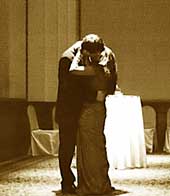|
|
“I liked holding the camera up to my face and hiding it,” Ryan Lobo writes in the ‘Concept Note’ to The Wedding Season, an exhibition of his 32 photographs, on display at the Seagull Arts and Media Resource Centre until February 25. He points out that he is not “a voyeur with these images”; in fact, he knows the people in them intimately. That sense of intimacy is captured by the eye of his camera. “I would smile and enjoy the intimacy I captured but found myself looking for the frayed edges, of bitching relatives and flirtatious grooms, of unfaithfulness, of jealousy, sadness and anger.” This could well have been the camera, and not Lobo himself, describing the emotions around these scenes gathered from various wedding parties.
Lobo, a professional documentary filmmaker, shot these images during a time in his life when his girlfriend had left him, his dog had died, and work had stopped being exciting. The wedding images reflect his ideas of love and fidelity, loss and suffering. The eye of his camera looks searchingly into the faces, for signs of joy and sadness, betrayal and trust. Mostly shot in black and white, the photographs capture people in various situations — in the middle of a wedding party, in an empty room, or in some private chamber after the party has ended. They appear in clusters, in pairs, or as intriguingly solitary in a crowd. Sometimes their faces come into focus, sometimes these faces are deliberately askew, appearing disturbingly fragmented.
Being a filmmaker, Lobo’s penchant for a ‘narrative’ is inescapable, but he works through suggestions without directly intruding into the imagination of the onlooker. His camera is sophisticated, reticent, and sharp: the images it captures, leave one wondering about the solitary figures who hover on the edges of these boisterous parties. They include the children forgotten by the adults, the awkward young people hiding away in the corners, and the old sitting quietly, often in the middle of the festivities, lost in their own worlds, smiling benignly to themselves. Equally fascinating are some of the couples — stealing a kiss as they dance, or caught in a moment of intimacy inside a mysteriously empty hall.
The one disappointing aspect of this otherwise excellent exhibition is the absence of the titles with the pictures, or even the sense of a sequence. Only the price list had the titles, numbered sequentially, when these should have been near the exhibits.











